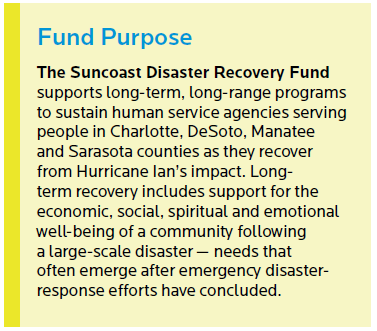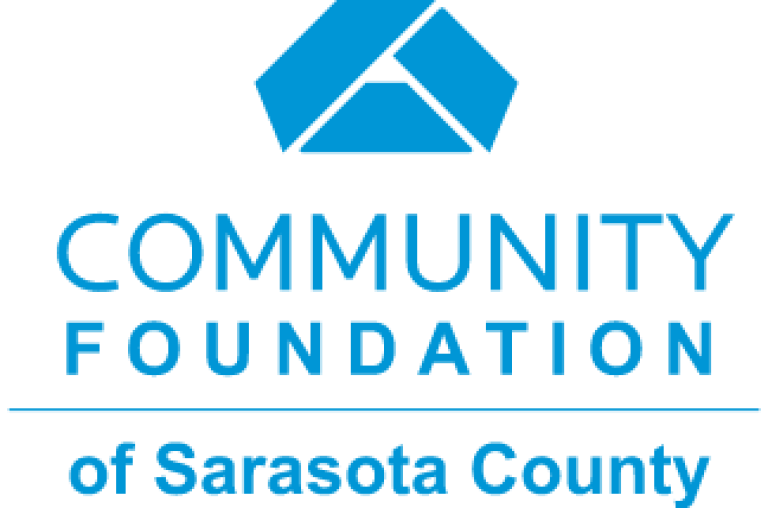June 1, 2023
A Time to Every Purpose
Categories: COMMUNITY CARE: Emergency Needs & Disaster Relief, Suncoast Disaster Recovery Fund,
“In recovery new needs continue to emerge. We continue to learn and unearth new things that you can’t know in those initial days, weeks, and months after a disaster.”
– Cari Cullen, director, Center for Disaster Philanthropy
It is our nature to mark time, to somehow map out the chaos of life into logical divisions – seconds, minutes, heartbeats, birthdays. As humans, we’re wired for measuring Chronos time, as the Greeks named it. We are creatures of the moment.
Of course, the Greeks had another name for time— Kairos—which lends itself to describing time as an alignment of conditions to make the most of a moment depending on many different factors.
Our Community Foundation has been balancing the tension between these two concepts of time as we thoughtfully manage the funds entrusted to us via the Suncoast Disaster Recovery Fund, which is designed to support long-term efforts to help our neighbors rebound and restore following a large-scale disaster. When Hurricane Ian struck southwest Florida in late September 2022, nearly 1,000 donors made $5 million in gifts to be a resource once the true impact of the storm could be assessed, and those gifts could be directed toward improving the sustainability and resiliency of our community.
“Disaster recovery—versus disaster response—requires the patience to listen and then build a thoughtful strategy that puts the people most affected in a place of empowerment,” said Roxie Jerde, president and CEO of the Community Foundation. “We are working with communities to tell us where they need help when they are at a place that can be assessed and shared. This is a people-centric approach.”
This is perhaps the most challenging part of helping with our region’s recovery—resisting the urge to jump right in—after all, responsiveness is critically important when addressing a crisis. We were fortunate, in the immediate aftermath, to have Season of Sharing dollars to assist people in need of immediate relief with housing or other hurricane-related loss. We were also able to draw upon our Student Emergency Fund to help in a time of acute crisis.
We learned through our research, however (see sidebar), that waiting is essential to allow true needs to be revealed after initial shockwaves of a disaster have passed. With guidance from community foundations in places like New Orleans and Jacksonville, Fla., where hurricanes have dramatically changed the community makeup, to other locales in Appalachia affected by floods, and those most unfortunately touched by mass shootings, we have heard similar advice: let time pass and become better informed.
“Relief is usually the first couple of days and weeks where we’re stabilizing chaos, but recovery requires a long-term lens,” said Cari Cullen, a director with Center for Disaster Philanthropy. “Recovery is holistic where we’re thinking about all the areas affected by a disaster—from education to health to the economy to agriculture to tourism—all those pieces that make a community thrive. In recovery new needs continue to emerge. We continue to learn and unearth new things that you can’t know in those initial days, weeks, and months after a disaster.”

Listening and Learning
To be a trusted resource when the survivors of a disaster are ready to plan their next stages, our team has relied upon our standard practice of listening to the people and nonprofit agencies that will enact the changes. With patience and strategy, we can be more assured that these changes will bolster our resilience in the face of the next disaster.
Our board-led Task Force was created to gather feedback and requests from nonprofit organizations, along with other community leaders, to understand where the support could be of the greatest use. We hosted meetings in the three areas most affected— southern Sarasota, Charlotte and DeSoto counties, where volunteers spanning civic, faith, business and government roles established volunteer Long Term Recovery Groups (LTRG), something most communities form post-disasters to coordinate support with existing, individual agencies. Kirsten Russell, Vice President of Community Impact, established the Community Foundation as a resource for each LTRG, which are also receiving input from colleagues with the Charlotte and Manatee Community Foundations and local United Way leadership.
We’ve learned the greatest impact our disaster fund can have for residents is in these key areas post-crisis:
• Legal aid
• Housing repairs and temporary shelter
• Mental health services
• Children and youth education to help with childcare and addressing achievement gaps.
• Unmet needs—requests that aren’t easily definable or supported by state or federal aid programs, or those offered by non-government organizations
“In this, we will do what we always do: listen to our community, our nonprofit partners, and experts from around the nation who can help us shape a response that will allow this community to heal and be better prepared for the next disaster,” said Jerde.
Trust from Within, and Afar
In recent years, when serious matters elsewhere in the country have arisen where charitable gifts can provide relief and effect change, our foundation has referred those wanting to help to work with the local community foundation. This was true in 2017 when Hurricane Harvey caused massive flooding in Texas and we were able to offer support through the Greater Houston Community Foundation, and similar referrals were made to The Miami Foundation following the collapse of the Surfside condominium.
With the Suncoast Disaster Recovery Fund, we found ourselves the recipient of the goodwill of others who rely on community foundations. While over 80 percent of gifts made to the fund were from within our fourcounty area, some 12 percent came from out of the state, many of these gifts through donor-advised funds with other community foundations. Amy Fair, Vice President of Donor Services with The Community Foundation of Middle Tennessee, which cited our Community Foundation as a resource to its fund holders, said referrals to local leaders for charitable gifts can be most impactful.
“We have been through five disasters (not counting COVID-19) since March 2020, so we empathize with the hurricane recovery efforts in Florida,” Fair said. “We believe in the power of a local community foundation to have the greatest knowledge and insights about their community, and so we point donors to community foundations in those impacted areas. The matching opportunity was especially highlighted.”
Fair is referring to the generous offer initiated by our partners at The Patterson Foundation. In the weeks following the storm, donors quickly completed a $750,000 dollar-for-dollar match from The Patterson Foundation that was put forward days ahead of Ian’s landfall. Along with this match, The Patterson Foundation also contributed a $500,000 initial gift to catalyze donations to the fund. The Patterson Foundation is a long-time collaborator with the Community Foundation of Sarasota County, strengthening efforts such as the annual Season of Sharing campaign and the Giving Challenge.
“For years, the Community Foundation of Sarasota County has worked to provide the givers in our region opportunities to channel their generosity toward outsized impact,” said Debra Jacobs, president and CEO of The Patterson Foundation. “The Suncoast Disaster Recovery Fund is the latest extension of their expertise in helping people contribute toward a better future for our community. It is a trusted resource for our region as we work to recover with resiliency.”
Key Milestones in Long-Term Planning
To ensure our commitment to addressing long-term recovery after Hurricane Ian to help our community once immediate needs subsided, our Community Foundation has dedicated the last six months to
listening and learning from more than 30 organizations impacted by the storm. With that critical input, we have been able to focus grantmaking on areas not adequately addressed through other supports,
and that will inform how our community will work together through future catastrophes.
- September: Suncoast Disaster Recovery Fund established (9/27/22); Hurricane Ian makes landfall in Southwest Florida as a strong Category 4 storm with a 240-mile reach. (9/28-9/29/22)
- October: A swift and strategic review of common disaster response funding gaps conducted by the Community Foundation resulted in the “Disaster Response Analysis” report to inform grantmaking to come.
- November: Nearly $5 million contributed in the six weeks since the storm for long-term recovery. At the same time, the foundation’s long-trusted “Season of Sharing” and “Student Emergency Funds” were used to help with immediate needs for housing, car repairs, clothing, and other basic needs.
- December: Task Force established and early feedback from community leaders in Charlotte, DeSoto and southern Sarasota County was collected.
- January/February: Task force site visits and listening sessions conducted to learn what each community’s greatest challenges, needs, and hopes are for a resilient recovery.
- March: Grantmaking priorities established by Task Force and Community Foundation’s Board of Directors to support legal aid, home repair programs, mental health support, education, and access to emergency financial support, as well as innovative, collaborative and strategic projects that will strengthen our region.
- April/May: First cycle of grant applications opened, to be awarded late Spring 2023.
Ongoing updates about the Suncoast Disaster Recover Fund are available on our website at cfsarasota.org/Suncoast-Disaster-Recovery-Fund
